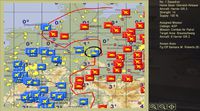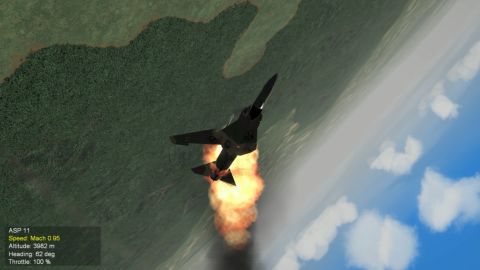Part 93: S15E04: 1979.09.24-25 (Coming From Behind)
S15E04: 1979.09.24-25 (Coming From Behind)1979.09.24

The front is quiet, but there's something strange in the neighbourhood.
The mission video

In which we blast through their fighters

Not a bad haul overall, and the casualties stay at nil.
1979.09.25

I ignore the resuming battles, and the game picks eight of us for a patrol.
The mission video

In which we keep blasting


No, Red Crown, you suck.

P.S. Africanus unveils the mysteries of CCIP
Africanus posted:
This is me watching Selenic dogfight:
Also a little about CCIP/Manual bombing etc:
CCIP or Constantly Computed Impact Point, is almost exactly as it describes itself.
Almost exactly?
Yes, ALMOST, the system isn't magic and has some limitations. Basically it uses your barometric altitude, airspeed, radar altimeter, pitot-static system, target or waypoint elevation etc. to place a spot on the ground where the selected ordnance is likely to fall if dropped right this instant. Considering the number of systems giving their input, there are quite a few variables that are constantly changing and the computer can't always keep up.
Another way to describe it is imagine a computer taking all this input and spitting out a solution(a pipper on the ground). If you fly in a straight line, at constant airspeed with your wings level the variables remain relatively stable, the calculations become simpler and your CCIP pipper remains relatively accurate. As you put more accelerations on the aircraft by say, diving in a turn with the power at the mil stop and accelerating, the amount of input to our poor computer increases and it begins struggling to keep up. As this continues your CCIP pipper becomes more and more inaccurate.
The most accurate way to employ CCIP:
-Spot your target several miles away(good luck, it's easier in real life, in sims it's ridiculous)
-Pick an altitude where you'll get AT LEAST a 30 degree dive angle on your bombing run. Try 8000ft to start.
-Fly offset from the target(IE not headings straight at it) so you can maintain visual contact until you roll in, otherwise it will disappear under the nose.
-Ensure your system is set up, ordnance and CCIP selected.
-When the target is approximately 30 degrees depressed from the horizon, overbank and pull your nose straight to the target or slightly above it(toward the horizon).
-Quickly roll wings level and place your flight path marker at 30 degrees nose low(if you have a pitch ladder this is easy, if not just place it on some piece of terrain a few degrees above the target and hold it there.
-If you need to make lateral adjustments, make them quickly and then return to wings level.
-As the CCIP pipper crosses the target(usually about 3000ft if you've done it right), pickle a bomb, pull up and initiate a climbing left turn back to 8000ft and extend away from the target at the reciprocal of your run in heading for another run. Check your hit and adjust for the next run. This works equally well fro forward firing ordnance(guns/rockets etc.)
The three patterns most used in training are:
High pattern (8000ft/30 deg) What I've just described.
Mid Pattern(5000ft/20 deg)
Low Pattern (3000ft/10 deg) Might be better for Selenic in this campaign since the fight ends up at low altitude anyway.
Manual bombing is a little different and a lot more difficult.
We saw manual bombing pippers in the early campaign. This takes the form of a fixed pipper in the gunsight.
For bombing the pipper is depressed from the nose a certain number of mils, or milliradians. There are different mil settings for the three different bombing patterns I've described above. For manual bombing you fly the same pattern as CCIP but here's the kicker, there's no computer doing the calculations for you, you need to fly the aircraft to the correct release altitude, at the correct dive angle and airspeed for the pipper to be valid.
Let me reiterate: The manual bombing pipper, specific to the mil setting is only accurate for a certain dive angle, airspeed and release altitude.
This article explains it better, even though it's for SFP1: http://www.simhq.com/_air/air_055a.html
The last thing is air to air gunnery with an LCOS or Lead Computing Optical Sight. These can be enhanced with a radar lock or not. Either way they are very useful.
Interesting anecdote: In Lomac/DCS, the F-15 LCOS gunsight, with a radar lock, not only solves for range, but also target aspect. This means that it doesn't just change the size of the pipper or the pipper's vertical location on the gunsight to solve for range, it physically moves the pipper to the place on the HUD where you'll get hits, even for snap shots. Literally all you have to do is put the pipper on the target, squeeze off a burst and you'll likely get a hit. Having never flown the F-15 I don't know if it's realistically that way or not but if you haven't tried DCS it's pretty fun and makes aerial gunnery stupid-easy.
This article goes into a fair bit of involved detail about air to air gunnery. For a discussion specific to LCOS, skip forward to page 10: http://www.simhq.com/_air9/air_269a.html
The whole article is excellent if you're new to sims or wanted to know the WHY of aerial gunnery.